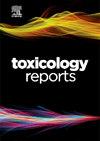水中硫酸盐对印度尼西亚西苏门答腊Sumpur河附近居民健康的非致癌影响风险评估
Q1 Environmental Science
引用次数: 0
摘要
广泛的农业活动有助于径流,并在全球许多水体中硫酸盐浓度升高中起重要作用。在热带地区,硫酸盐污染及其相关的健康危害加剧,成为国际关注的问题。然而,这些问题往往被忽视,尽管它们对水和公民安全有潜在的影响。鉴于硫酸盐污染对该地区水质的重大影响,本研究打算评估硫酸盐污染对人类健康构成的风险。评估是通过在辛卡拉克湖沿森普尔河及其河口建立的七个水样站进行的。对采集样本的分析表明,所有地点的硫酸盐浓度都保持在允许的范围内,证实了水的适宜性。所有采样地点的硫酸盐污染指数(SPI)值都低于1,就硫酸盐含量而言,它们被归类为未污染。此外,所有地点的危害指数(HI)值均低于1,表明对公众没有重大的非致癌性健康风险。但是,S5地区的平均HI值最高,接近1(0.95)。在靠近稻田和河岸定居点的S5采样观测中,有一个值超过1,需要引起注意。可持续的农业管理对于减轻潜在的健康和危险硫酸盐污染以及确保该区域消费用水的安全至关重要。减轻农业和居民区的硫酸盐污染需要技术、教育和监管执法的结合。这一办法应使社区积极参与,以创造一个更健康和更可持续的环境。本文章由计算机程序翻译,如有差异,请以英文原文为准。
Risk assessment for non-carcinogenic effect posed by sulfates in water on the health of residents around The Sumpur River, West Sumatra-Indonesia
The extensive agricultural activity contributes to runoff and plays a significant role in elevated sulfate concentrations in many global water bodies. In tropical regions, sulfate pollution and its associated health hazards have intensified, emerging as an international concern. However, these issues are often overlooked despite their potential impact on water and citizen safety. Present study intends to assess the risks posed by sulfate contamination to human health, given its critical implications for water quality in the area. The assessment was conducted through observations in seven water sampling stations established along the Sumpur River and its estuary in Lake Singkarak. The analysis of the collected samples reveals that sulfate concentrations at all locations remain within permissible limits, confirming the water's suitability for consumption. The Sulfate Pollution Index (SPI) values at all sampling locations are below 1, classifying them as unpolluted with respect to sulfate content. Additionally, the Hazard Index (HI) values at all locations were below 1, indicating no significant non-carcinogenic health risks to the public. However, location S5 recorded the highest average HI value, nearing 1 (0.95). One of sampling observations at S5, located near rice fields and settlement areas along the riverbanks, showed a value exceeding 1, which requires attention. Sustainable management of agricultural is crucial for mitigating potential health and dangers sulfate contamination and ensuring the safety of water for consumption in this region. Mitigating sulfate pollution from agriculture and residential areas requires a combination of technology, education, and regulatory enforcement. This approach should actively involve the community to create a healthier and more sustainable environment.
求助全文
通过发布文献求助,成功后即可免费获取论文全文。
去求助
来源期刊

Toxicology Reports
Environmental Science-Health, Toxicology and Mutagenesis
CiteScore
7.60
自引率
0.00%
发文量
228
审稿时长
11 weeks
 求助内容:
求助内容: 应助结果提醒方式:
应助结果提醒方式:


